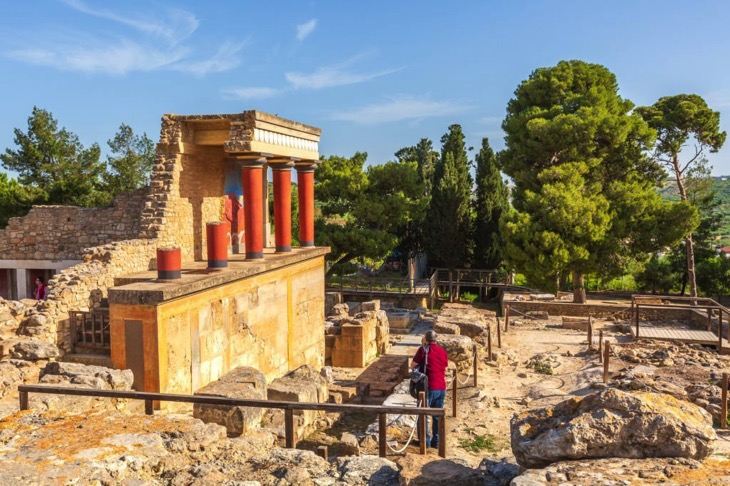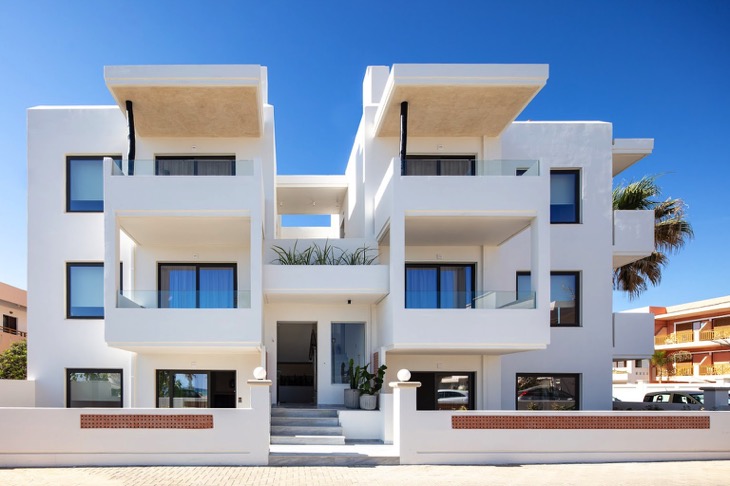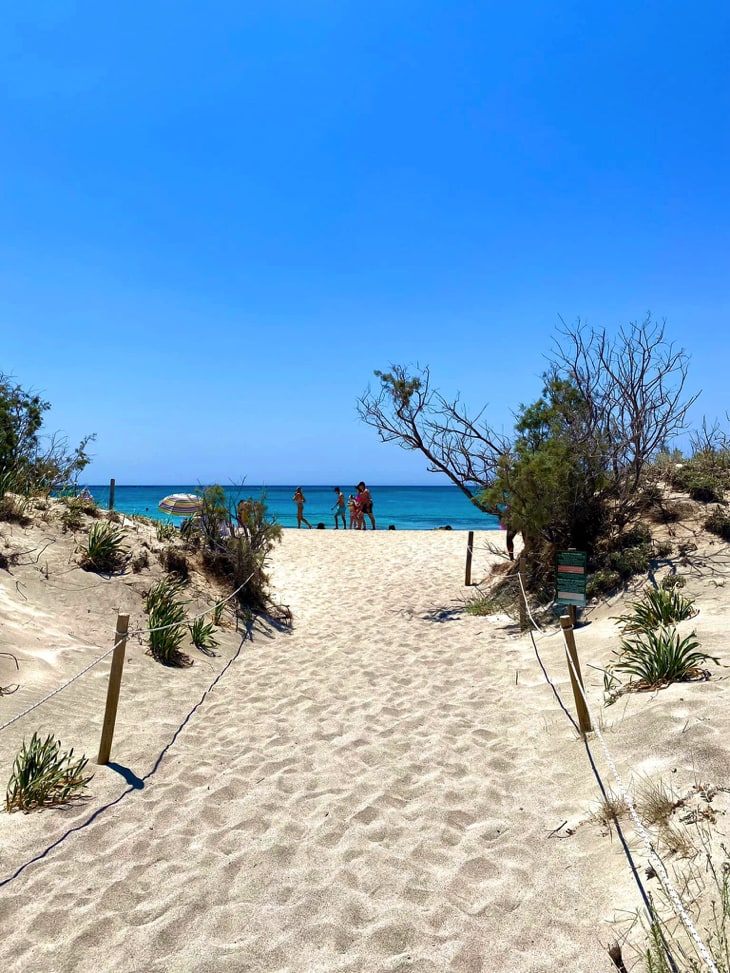Best Time to Visit Crete: Climate, Weather and Temperature

Travellers enjoy a variety of experiences on Crete, the largest and southernmost Greek island. Personal preferences and the desired type of experience help determine the best time to visit Crete. The summer months of June to August are ideal for enjoying warm weather and the best beaches in Crete. The island is crowded with tourists during the busiest time of year and visitors take advantage of the island’s sun-drenched beaches and exciting nightlife. Big tourist attractions are crowded during peak season.
The mid-seasons of spring (April to May) and fall (September to October) are ideal for people looking for a more relaxing experience with cooler temperatures. Crete in April blooms with bright landscapes during spring and the weather is mild and pleasant, making it an ideal season for outdoor activities such as trekking and touring. Autumn provides good temperatures and fewer tourists, allowing people to explore the island’s historic legacy without the summer hordes.
The winter season, which lasts from November to March, is a fantastic choice for people who are on a tight budget. The weather in Crete in March is cooler and prices are often lower during the winter season and fantastic savings on lodging and flights are discovered. There are tourist attractions closed and the weather is chilly with occasional showers. Winter is great for visitors who wish to relax and discover the island’s history and natural beauty without crowds.
Crete experiences four distinct seasons, each with its unique charm. Spring and autumn offer mild temperatures and are excellent for outdoor activities and exploring historical sites. Summer provides the classic Mediterranean beach experience, with hot and dry weather perfect for sunbathing and water sports. Winter offers a quieter ambience, lower prices and opportunities to delve into Crete’s cultural heritage.
Crete is located in the eastern Mediterranean Sea, approximately 160 km (100 miles) south of the Greek mainland. Crete’s geographic coordinates are approximately 35.2401° N latitude and 24.8093° E longitude. Crete’s strategic location provides gorgeous coasts, attractive villages and a rich cultural legacy influenced by ancient civilisations.
Several factors must be considered when booking a trip to Crete. Take into account the type of weather preferred and plan the visit accordingly. Consider the cost implications of travelling during peak season versus the shoulder or off-peak seasons. Research the things to do in Crete and choose a season that aligns with the identified preferences. Check for any cultural events or festivals happening during the visit, as they add a unique and enriching experience to the trip. Book accommodations well in advance, especially during peak season, to secure preferred options.
When Is the Best Time to Visit Crete?
The best time to visit Crete depends on personal tastes and the type of experience desired. The summer months from June to August are considered the busiest in Crete, according to historical statistics and visitor trends. The island sees a substantial increase in visitors during the summer season.
Crete’s summer season is hot and dry, making it ideal for beach holidays and water activities. The island’s gorgeous beaches, crystal-clear waters and vibrant beach resorts draw visitors from all over the world. Summer is the busiest season for travellers when people take advantage of school breaks and vacation time.
Famous tourist sights such as the Palace of Knossos, Samaria Gorge and Balos Beach are best visited during the summer. Accommodation prices tend to be higher during the summer, making it advisable to book ahead of time to secure preferred options and ensure a smooth and enjoyable stay. The nighttime scene is alive and well, with beach clubs, pubs and restaurants teeming with activity.
The island of Crete provides a nice experience throughout the year. Spring (April to May) and autumn (September to October) are major tourist seasons. The spring and autumn seasons offer milder weather, fewer crowds and a more laid-back atmosphere. They are ideal for seeing historical sites, wandering through gorgeous landscapes and immersing oneself in the rich culture of the island.
Crete has a decrease in tourist numbers during the winter months of November to March. Certain tourist attractions are closed because of the cooler weather. The winter months from November to March present an excellent opportunity to visit Crete, for travellers on a budget or visitors seeking a more tranquil experience. Prices for lodging and flights are often lower and the island takes on a more serene air. It is a wonderful opportunity to see historical and ancient sites without crowds, making it an important element of a Crete travel guide for anyone wishing to discover the island’s rich past in a tranquil atmosphere.
What are the Climate Characteristics of Crete?
Crete features a Mediterranean climate with hot, dry summers and mild, rainy winters. Summers bring high temperatures ranging from 28 ℃ (82,4 ℉) to 35 ℃ (95 ℉) and almost no rainfall, particularly in July, the least rainy month with just 3 mm (0.1 inches) of precipitation. The long, sunny summers support tourism and outdoor activities, while winter rainfall sustains crops like olive groves and citrus orchards. The best time to visit Crete depends on your interests. Late April to early June and September to early October are ideal for warm weather, fewer crowds, and outdoor activities. For lively nightlife and beach vacations, July and August are popular but bring higher temperatures and larger tourist crowds.
What is Crete temperature by month?
Crete’s temperature by month ranges from mild winters to warm summers. January has an average high of 14.09 ℃ (57.36 ℉) and a low of 11.57 ℃ (52.83 ℉), with a daily mean of 13.15 ℃ (55.67 ℉). August is the hottest month, with an average high of 27.28 ℃ (81.10 ℉), a low of 24.42 ℃ (75.96 ℉), and a daily mean of 26.47 ℃ (79.65 ℉). Winter months remain mild, while summer months bring significant warmth.
Find below a table of monthly temperatures in Crete.
| Month | Average High (°C) | Average Low (°C) | Daily Mean (°C) |
|---|---|---|---|
| January | 14.09 °C | 11.57 °C | 13.15 °C |
| February | 14.86 °C | 12.14 °C | 13.83 °C |
| March | 16.03 °C | 13.05 °C | 15.01 °C |
| April | 17.96 °C | 14.94 °C | 17.03 °C |
| May | 21.40 °C | 18.28 °C | 20.48 °C |
| June | 24.61 °C | 21.71 °C | 23.81 °C |
| July | 26.85 °C | 23.94 °C | 26.07 °C |
| August | 27.28 °C | 24.42 °C | 26.47 °C |
| September | 25.72 °C | 22.77 °C | 24.80 °C |
| October | 22.41 °C | 19.81 °C | 21.48 °C |
| November | 19.21 °C | 16.87 °C | 18.36 °C |
| December | 15.84 °C | 13.53 °C | 14.96 °C |
As the table above shows, Crete temperature variations over the year show August as the hottest month with an average high of 27.28 °C (81.1 ℉) and a daily mean of 26.47 °C (79.6 ℉), while January is the coldest with an average high of 14.09 °C (57.4 ℉) and a daily mean of 13.15 °C (55.7 ℉). Significant warming occurs during the transition from spring to summer, with daily means increasing from 15.01 °C in March to 23.81 °C in June.
What Are the Different Seasons in Crete?
Listed below are the different seasons in Crete.
- Spring: Spring in Crete has a moderate number of visitors , making it a great season for visitors wanting a more leisurely experience. Temperatures steadily rise from 16°C (61°F) in March to 24°C (75°F) in May. Visitors have the opportunity to explore lovely towns such as Chania and Rethymno, visit the ancient site of Knossos, climb through the spectacular Samaria Gorge and relax on the beautiful beaches of Elafonisi and Balos.
- Summer: The summer season in Crete attracts a large number of tourists, particularly in July and August. Temperatures range from 25°C (77°F) in June to 30°C (86°F) in August. The beaches and coastal sections of the island are popular, with pleasant sea temperatures ideal for swimming and aquatic activities. Tourists enjoy the beautiful beaches of Agios Nikolaos, Falassarna and Vai, including ancient monuments such as the Palace of Phaistos and the island of Spinalonga and active nightlife in Malia and Hersonissos.
- Autumn: Tourist visitation in Crete starts decreasing in the autumn, but the island remains very active, particularly in September. The weather is pleasant and mild, with highs of 24°C (75°F) in September and lows of 18°C (64°F) in November. The Autumn season is perfect for outdoor activities and tourism. Discover the small town of Agia Galini, climb through the majestic Imbros Gorge and relax on the gorgeous beaches of Preveli and Matala.
- Winter: Winter is the off-season in Crete, attracting fewer tourists than other seasons of the year, resulting in a quiet and peaceful atmosphere. The weather is pleasant, but rain is more common. Temperatures in December range from 16°C (61°F) to 14°C (57°F) in February. Winter is ideal for exploring indoor sites such as the Archaeological Museum of Chania, visiting historical monasteries, experiencing the charm of villages such as Archanes and relaxing on Agios Pavlos Beach.
What is the Type of Climate in Crete?
Crete most areas fall under the hot-summer Mediterranean classification (Csa). Southern and eastern regions experience a hot semi-arid climate (BSh). Mountainous areas feature cooler climates, including warm-summer Mediterranean (Csb) and cold-summer Mediterranean (Csc) at higher elevations.
The south coast, influenced by the North African climatic zone, experiences more sunny days and higher temperatures. Coastal areas remain humid due to the sea, while inland regions can become semi-arid in summer. Crete receives over 3,250 sunshine hours annually and records some of Europe’s highest winter temperatures.
How is summer in Crete?
Summer spans June to September, with hot, dry weather and minimal rainfall. Temperatures range from 28 ℃ (82,4 ℉) to 35 ℃ (95 ℉), especially in southern areas, with occasional peaks above this range. Coastal regions experience cooling northwest breezes. The sea temperature rises to 25 ℃ (77 ℉) by August. Long daylight hours (up to 12 hours daily) and clear skies make this season ideal for beaches, water sports, and exploring coastal towns.
How Long is Winter in Crete?
Winter in Crete lasts from Dcember to mid-March, with coastal temperatures ranging from 10 ℃ (50 ℉) to 15 ℃ (59 ℉) and sub-zero temperatures in the mountains. Snow is common in mountainous regions but rare along the coast. December is the wettest month, while January and February are slightly drier with occasional rainfall. Winds near the sea can intensify the cold. Winter is ideal for cultural exploration, hiking, and visiting archaeological sites, with fewer tourists present.
How is Spring in Crete?
Spring lasts from March to May, featuring blooming landscapes, rising temperatures 10 ℃ (50 ℉) to 50 ℉ (75.2 ℉), and decreasing rainfall. Rain averages six days in March but only two in May. Wildflowers and herbs flourish, creating vibrant scenery. Late spring brings warming sea temperatures 19 ℃ (66.2 ℉), making swimming possible. Spring offers excellent conditions for hiking, cycling, and enjoying fresh local produce like wild greens and artichokes.
When Is the Best Time to Visit Crete for Swimming?
The best time to visit Crete for swimming is during the summer, which lasts from June to September. Summer is the busiest tourism season in Crete, attracting visitors from all over the world. The weather is bright and sunny throughout the season, making it ideal for swimming and relaxing on the island’s gorgeous beaches.
Crete has mild and pleasant weather during the summer months. Temperatures rise in June, averaging around 25°C (77°F). Summer’s warmest months are July and August, with temperatures reaching around 30°C (86°F). The pleasant weather continues into September, with temperatures gradually cooling. Summer is the perfect time for swimming and other water sports due to the pleasant weather and the warmth of the Mediterranean Sea.
Summer in Crete provides a time of exciting cultural events and festivities. The Feast of St. John the Baptist, for example, is celebrated on June 24th with ancient customs, music and dance. The events in Crete give travellers the opportunity to experience local culture firsthand and learn about the rich traditions of the island. The Renaissance Festival takes place in Rethymno every August, showcasing theatre performances, concerts and art exhibitions. The activities contribute to the living environment and provide guests with unforgettable memories.
The best months to swim in Crete are June, July, August and September. The sea temperatures during summer are pretty nice, ranging from roughly 22°C (72°F) in June to 25°C (77°F) in August. The summer months provide several opportunities to engage in aquatic experiences such as relaxing on the best beaches in Crete, finding secluded coves or participating in exciting water activities such as jet skiing or windsurfing.
When Is the Best Time to Visit Crete for Sightseeing?
The best time to visit Crete for sightseeing is in the spring and autumn. The Autumn and spring seasons provide milder temperatures, fewer crowds and nice weather, making it a perfect time to see the island’s attractions.
Temperatures progressively rise in Crete throughout the spring season, which lasts from March to May. Temperatures in March range from roughly 16°C (61°F) to 24°C (75°F) in May. Colourful flowers and verdant scenery bring the island to life, giving a lovely backdrop for visitors.
The weather is ideal for touring Crete’s sites from September to November. Temperatures fluctuate between 24°C (75°F) in September and 18°C (64°F) in November. The island is starting to take on its autumnal hues and the weather is still good, making for a lovely backdrop for tourist excursions.
The absence of large crowds is one advantage of visiting Crete in the spring and autumn. The Spring and autumn seasons are less crowded than the high summer months, allowing visitors to see attractions and historical sites without feeling overwhelmed. The experience becomes more authentic and relaxed, allowing for interaction with locals and engagement in the island’s rich culture.
Crete visitors do have an opportunity to learn about Cretan culture and traditions, even though spring and fall do not hold significant events such as the peak summer season. Travellers have the opportunity to take part in smaller-scale festivals and activities, sample traditional Cretan food and interact on a more intimate level with the local population.
The best months to visit Crete for sightseeing are March, April, May, September, October and November. The weather is good throughout the autumn and spring season, making it easy to see archaeological sites such as the famous Palace of Knossos, the historical town of Chania, the ancient remains of Phaistos and Gortyna and the spectacular Samaria Gorge. Travellers have the option of participating in activities such as trekking, visiting traditional villages and admiring the island’s scenic surroundings.
Spring provides an opportunity to see the beautiful flora, with blooming flowers and colourful scenery. Autumn shows the island’s bountiful harvest season, allowing an opportunity to partake in traditional festivals and savour local gastronomic delicacies.

When Is the Best Time to Visit Crete for Hiking Adventures?
The best time to visit Crete for hiking adventures is during the spring (March to May) and autumn (September to November) seasons. The Spring and autumn seasons provide ideal weather and circumstances for outdoor enthusiasts to enjoy the island’s hiking routes and natural scenery.
Spring in Crete brings pleasant temperatures as the island emerges from its winter hibernation. Temperatures rise steadily from roughly 16°C (61°F) in March to 24°C (75°F) in May, making for pleasant trekking conditions. The sceneries come alive with blossoming flowers and lush greenery, providing hikers with a stunning backdrop.
Autumn in Crete has moderate temperatures ranging from 24°C (75°F) in September to 18°C (64°F) in November. The weather is usually consistent during this time of year, making it excellent for hiking adventures. Autumnal colours and gentle light contribute to the charm of the paths, making for a spectacular and delightful trip.
The absence of large crowds is one benefit of hiking in Crete during the autumn and spring seasons. Spring and autumn are less crowded than the peak summer months, allowing hikers to completely immerse themselves in the island’s natural beauty and appreciate the tranquilly of the trails. The quieter setting makes for a more calm and peaceful hiking experience.

Spring and autumn do not have big hiking events, but they do provide a more quiet and less crowded atmosphere, allowing hikers to connect with nature and truly appreciate Crete’s breathtaking scenery. The lack of large crowds makes it easier to study the island’s distinctive flora and animals in a more tranquil atmosphere.
The best months for hiking in Crete are March, April, May, September, October and November. Hikers take advantage of the pleasant weather and less congested paths during that time. There are several hiking alternatives available, ranging from coastal walks with spectacular views of the sea to highland routes that lead hikers through gorges, plateaus and traditional towns. Popular hikes for adventurers include the Samaria Gorge, Imbros Gorge and the E4 European long-distance trail.
The Spring and autumn seasons offer opportunities for various outdoor activities. Visitors engage in birdwatching and nature photography and explore archaeological sites that are discovered along some hiking paths. The mild temperatures and favourable weather conditions make spring and autumn the ideal seasons for fully appreciating and experiencing Crete’s natural beauty.
When Is the Best Time to Visit Crete for Island Hopping?
The best time to visit Crete for island hopping is during the summer season, which runs from June to September. Summer is the best time to visit the nearby islands and enjoy the Mediterranean charm.
Crete has warmer temperatures and plenty of sunshine during the summer months. Temperatures range from 25°C (77°F) in June to 30°C (86°F) in August, making it ideal for island hopping experiences. The warm weather allows for comfortable boat rides and the appealing sea temperatures make swimming and other aquatic activities a great option.
The Potato Festival at Tzermiado on the Lasithi plateau is one of the major activities that tourists to Crete take part in throughout the summer. The celebration honours the region’s agricultural past and concentrates on the potato, one of the plateau’s principal crops. The Potato Festival provides a one-of-a-kind cultural experience, with traditional music, dance performances, local specialities and a variety of potato-based cuisine. It allows visitors to immerse themselves in Cretan customs and flavours while enjoying the exciting ambience of this festive event.
The months of June, July, August and September are ideal for island hopping in Crete. The Summer season provides the most consistent weather, warm sea temperatures and extended daylight hours. Visitors make the most of their island adventure by maximising their time to visit different sites and delight in their unique features.
Island hopping in Crete offers a range of activities and experiences. Renowned islands such as Santorini, Mykonos, Rhodes and others each have their own distinct character and attractions. Visitors enjoy leisurely strolls through picturesque villages, relax on pristine beaches, savour delectable local cuisine and immerse themselves in the cultural heritage of each island. The Greek islands provide a variety of experiences to suit a variety of tastes, whether they are looking for a busy nightlife, historical monuments or quiet scenery.
When Is the Best Time to Visit Crete for Cheaper Hotels?
The shoulder seasons of spring (March to May) and fall (September to November) are the best times to visit Crete for lower accommodation rates. The shoulder seasons of spring are less expensive than the busy summer season, allowing travellers to save money on lodging.
Tourist activity in Crete is often reduced during the shoulder seasons, resulting in lower hotel rates. Hotels are more inclined to offer discounted rates and incentives to entice tourists because the island is not in its peak tourist season. It is a fantastic opportunity for budget-conscious travellers to enjoy a low-cost vacation in Crete.
Spring and autumn provide excellent conditions for exploring the island. Temperatures progressively rise in the spring, ranging from roughly 16°C (61°F) in March to 24°C (75°F) in May. Temperatures in the autumn range from 24°C (75°F) in September to 18°C (64°F) in November. The temperatures offer comfortable conditions for outdoor activities and tourism even though they are not as hot as in the summertime.

The best months to book a hotel in Crete are March, April, May, September, October and November. Travellers are taking advantage of cheaper prices and promotions during the shoulder seasons, making their trips more affordable. Keep in mind that even while the costs are lower, not all tourist services and amenities are readily available as they are during the busiest summer months. Travellers must book lodgings ahead of time and explore the individual amenities and services provided by hotels during certain times.
When Is the Low Season for Crete?
The winter months are the low season for Crete, with fewer visitors. Crete’s tourism activity drops during the winter period due to a variety of circumstances.
Crete gets few visitors throughout the winter months of December, January and February. The milder weather, with typical temperatures ranging from 10°C (50°F) to 15°C (59°F), makes it less appealing for beach-related activities, which are a significant draw for travellers during the summer season. Many tourists choose warmer areas for their vacations, resulting in a decrease in visitor numbers in Crete during the winter months.
The low season in Crete provides a more tranquil and pleasant atmosphere, with fewer crowds at famous tourist sites and attractions. The low season provides tourists with a more intimate experience by allowing them to explore popular destinations without the usual crowds and bustle. Lodging and transportation costs are lower during the low season, making it a more cost-effective time to visit Crete.
Low season offers benefits such as fewer crowds and lower prices, some tourist services, shops and attractions operate on limited hours or not at all. Verify and plan ahead of time to ensure that preferred activities and amenities are accessible during the stay.
What are the Best Places to Visit in Crete Per Season?
Listed below are the best places to visit in Crete by season.
- Chania: Chania is recognised for its lovely ancient town and Venetian harbour. Chania is best visited in spring, when the weather is mild and the streets are decked with flowering flowers.
- Samaria Gorge: Spring is an excellent season to walk the Samaria Gorge, Europe’s longest gorge. The gorge is overflowing with lush vegetation and in-bloom flowers and the temperature is pleasant. The Samaria Gorge is just one example of the many parks and nature attractions in Crete that offer incredible experiences during the spring season.
- Heraklion: Heraklion combines history with dynamic metropolitan life. The ancient ruins of Knossos are worth exploring in the summer and visitors take in the bustling ambience of the city’s cafés and restaurants.
- Balos Beach: Balos Beach is a must-see throughout the summer months with its turquoise waves and breathtaking views. Take a boat journey to the isolated beach to experience the unspoiled beauty of the Cretan coastline.
- Rethymnon: Rethymnon is best visited in the autumn when the weather is pleasant but the tourists have thinned. Explore the old town’s small lanes, see the majestic Fortezza and unwind on the gorgeous Rethymnon Beach.
- Elafonisi Beach: Elafonisi Beach is well-known for its pinkish sand and clean waves and in the autumn it transforms into a tranquil haven. Travellers have the option of going to the beach without having to deal with the summer crowds because the weather is nice.
- Agios Nikolaos: The charming coastal town of Agios Nikolaos is an excellent winter destination. Enjoy the warm winter weather by visiting the picturesque Lake Voulismeni and exploring the local stores and cafés.
- Lasithi Plateau: Winter is the greatest time to explore the Lasithi Plateau since it changes into a winter paradise with snow-capped peaks. Explore the historic villages and relax in the plateau’s tranquil and peaceful ambience.

When Should You Book Your Visit to Crete?
You should book your visit to Crete many months in advance to ensure a pleasant and well-organised trip. Early booking helps to get the best deals on flights, hotels and other vital reservations. Planning ahead increases the chance of acquiring preferred options and benefiting from early booking discounts or promotions.
Make reservations for hotels in Crete immediately, especially during the busy summer season. The Summer season is when there is the most demand and availability is limited. Booking accommodations several months in advance gives a larger range of possibilities and ensures getting the best pricing. There is more flexibility in terms of last-minute bookings or locating available rooms during the shoulder or low seasons.
Start looking for flights three to six months before the anticipated travel dates when it comes to reserving aircraft tickets. Take advantage of early bird discounts and secure lower costs. Prices fluctuate due to factors such as season, demand and airline promotions, so it is always a good idea to monitor prices and book when a suitable fare is found.
Additional travel arrangements, such as vehicle rentals, transit within Crete and any particular tours or activities planned, must be taken into account in addition to lodging and flights. Some trips and activities, particularly in popular destinations, have limited availability or require advance booking. Preparing ahead of time by researching and booking these arrangements ensures availability and helps minimise last-minute regrets.
What Are the Things to Consider when Booking for Crete?
Listed below are the things to consider when booking for Crete.
- Travel Dates: Determine the best time of year to visit Crete. Consider the weather, high visitor seasons and any specific events or festivals that one wishes to attend.
- Budget: Make a trip budget that includes the costs of lodgings, transportation, food, activities and any other expenses. Consider the currency conversion rates and the general cost of living in Crete.
- Accommodations: Choose the best type of lodging, such as a luxury resort, a budget-friendly hotel, a vacation rental or a traditional guesthouse. Research and compare the available options, taking into consideration factors such as location, amenities and guest reviews.
- Transportation: Determine how to get to Crete and whether flights, ferry tickets or other modes of transportation are required. Consider renting a car if visitors are planning to explore the island independently.
- Duration of Stay: Decide how long to stay in Crete. Determine the number of days required to visit the major sights and participate in desired activities.
- Itinerary: Make a basic schedule of the locations to see and things to do in Crete. Look into the hours of operation and availability of attractions, tours and events.
- Travel Insurance: Consider obtaining travel insurance to safeguard against unforeseen situations such as trip cancellations, medical problems or misplaced luggage.
- Health and Safety: Check the most recent travel advisories and be aware of any health and safety recommendations or regulations when visiting Crete. Consult a healthcare provider if any immunisations or precautions are required.
- Cultural Etiquette: Research the local customs and cultural norms of Crete to ensure respectful behaviour during the visit.
- Reviews and Recommendations: Seek out reviews and recommendations from other travellers, travel websites or online forums to gather insights and make informed judgements.
Why Is It Best to Rent a Car in Crete?
Renting a car provides the flexibility to navigate the island at one’s own pace and convenience, allowing for optimal use of time and the ability to experience all that Crete has to offer. Renting a car in Crete provides various benefits, making it the finest alternative for touring the island. Crete is a huge and diverse island with gorgeous landscapes, quaint villages and hidden jewels strewn about.
The freedom that renting a car provides is one of its primary benefits. The freedom to plan a unique itinerary and visit off-the-beaten-path locations that are not conveniently reachable by public transit is provided by having a car at one’s disposal. Exploring quiet beaches, driving into the highlands or visiting rural towns for a more real experience of Crete becomes accessible with the freedom of a rental car. The level of adaptability allows the discovery of hidden treasures and one-of-a-kind experiences not attainable with other forms of transportation.
Renting a car provides convenience and time savings. Having a rental automobile instead of relying on public transit schedules or waiting for taxis provides for the establishment of a personalised itinerary and the opportunity to move around the island easily. Renting a car is good for itinerary optimisation, seeing numerous destinations in a day and having the flexibility to adjust plans as needed.
A rental car is very useful for enjoying Crete’s picturesque drives. The island is noted for its magnificent landscapes, which range from steep highlands to scenic coastal roads. Having a car makes it easy to go on road excursions and take in the breathtaking countryside at one’s own speed. The simplicity of a rental car makes driving through the Samaria Gorge, following coastal routes to areas such as Elafonisi or exploring the mountainous regions of Lassithi easy and fun. The flexibility of having a rental car allows for stops at vistas, taking in the beauty of the island and taking great images.
Renting a car gives comfort and convenience, especially when travelling with family or in a group. Controlling the temperature, music and general travel experience improves the experience and creates a comfortable setting for everyone. Visitors are going to enjoy their travel experience by choosing the right car to rent in Crete.
What is Crete Vegetation Like?
Crete’s vegetation is rich and diverse, with over 1,600 plant species, including 10% that are endemic. The Mediterranean climate supports sclerophyllous evergreen and oak forests, maquis shrublands with thyme and sage, and high mountain flora like cypress woodlands, thorny shrublands, and unique species such as the Cretan maple.
Sclerophyllous forests dominate the region, featuring kermes oak, carob, juniper, and tree-spurge. Maquis shrublands host thyme and sage. Lefka Ori and Psiloritis mountains sustain cypress woodlands, thorny shrublands, and endemic species like Cretan maple.
What do Fruits grow in Crete?
Crete grows oranges, apricots, cherries, bananas, and avocados. Oranges from Maleme are prized for their taste. Apricots ripen in late spring, cherries from Gerakari peak in summer, southeastern bananas are aromatic and flavorful, and avocados thrive due to the mild climate, offering healthy fats and vitamins.
What do Vegetables grow in Crete?
Crete’s fertile soil and Mediterranean climate support the growth of vegetables such as tomatoes, zucchini, wild greens like stamnagathi, eggplants, and cucumbers. These staples are central to Cretan cuisine, used in salads, stews, and traditional dishes, with many prized for their natural sweetness, crisp texture, and adaptability to local recipes.
Find below a list of vegetables that grow in Crete.
- Tomatoes: Tomatoes are a staple in Cretan cuisine, used in salads, stews, and sauces. They are known for their natural sweetness and high antioxidant content, as they ripen naturally.
- Zucchini: Zucchini is widely used in Cretan cooking, often fried, stuffed, or included in vegetable medleys. Its blossoms are also delicacies, typically stuffed with local cheeses or herbs.
- Wild Greens (Horta): Wild greens, or horta, are foraged from the hillsides and include varieties like stamnagathi (wild chicory). These greens are typically boiled and served with olive oil and lemon.
- Eggplant: Eggplants are central to many traditional recipes, including moussaka and imam bayildi (stuffed eggplant). They are often grilled or baked to bring out their smoky flavor.
- Cucumbers: Cucumbers are refreshing vegetables commonly used in salads, especially the iconic Greek salad. They are in Crete’s warm climate and are known for their crisp texture.
How Much Does It Rain in Crete?
Crete experiences most of its rainfall between October and March, with December and January receiving 80mm to 120mm. Mountainous areas get more rain than coastal regions. Summers, from June to August, are typically dry, contributing to the island’s semi-arid climate.
Does It Snow in Crete?
Snow falls regularly in Crete’s mountainous regions, such as Lefka Ori and Psiloritis, between January and March, occasionally persisting on peaks into early summer. Snowfall at coastal or low elevations is rare, brief, and occurs during infrequent cold spells.
What is the Wettest Month in Crete?
December is the wettest month in Crete, with average precipitation ranging from 77 mm to 120 mm depending on the specific location on the island.
Here is the average precipitation per month:
- December: Wettest month with 89-95 mm of rain and 10 rainy days.
- January: 90 mm of rainfall across 10 rainy days.
- February: 65-77 mm of rain over 8-9 rainy days.
- March: 50 mm of rain with 6 rainy days.
- April: 25-30 mm of rain over 3 rainy days.
- May: Dry, with 13-15 mm of rain and 2 rainy days.
- June-August: Almost no rainfall during summer months.
- September: 10-20 mm of rain over a few days.
- October: 45-70 mm of rain over several days.
- November: 58-68 mm of rain across 6 rainy days.
What is the Least Rainy Month in Crete?
July is the least rainy month in Crete, characterized by its minimal precipitation, averaging 3 millimetres (0.1 inches). This period marks the peak of the dry season on the island, with long, sunny days and almost no rainfall. The dry conditions are typical of Crete’s Mediterranean climate, which features hot, arid summers. This lack of rain makes July ideal for outdoor activities and beach visits, as the weather is consistently warm and clear.
What are the Highest Temperatures in Crete?
The highest temperatures in Crete are typically recorded during July and August, when the average maximum temperature ranges from 26 ℃ (78,8 ℉) to 30 ℃ (86 ℉). However, extreme heat waves can push temperatures even higher. For instance, Moires in Crete recorded a temperature of 45,9 ℃ (114,6 ℉) on July 1, 2017, highlighting the potential for intense summer heat.
What are the Lowest Temperatures in Crete?
The lowest temperatures in Crete occur during the winter months, particularly in January and February. During this time, average minimum temperatures can drop to around 9 ℃ (48,2 ℉) to 11 ℃ (51,8 ℉) in coastal regions. In mountainous areas, temperatures can fall below freezing, especially at night. February is considered the coldest month, with average maximum daytime temperatures around 13 ℃ (55,4 ℉).
Is it Hard to Live in Crete because of the weather?
No, living in Crete offers a generally pleasant climate. Some people might find adapting to the summer’s high temperatures challenging, particularly if they are not accustomed to such climates. Winters are mild compared to northern Europe but can be damp and windy, which might require some adjustment for those used to more insulated homes.
How does weather affect the Life in Crete?
The weather in Crete significantly influences daily life and activities on the island. The long, sunny summers are ideal for tourism, agriculture, and outdoor activities like hiking and water sports. The mild winters allow for continued outdoor exploration but also bring necessary rainfall that supports agriculture, particularly olive groves and citrus orchards. Seasonal winds like the Meltemi provide relief during hot months but can also affect sailing conditions. Climate change poses challenges by altering traditional weather patterns, potentially impacting agriculture and tourism with increased temperatures and unpredictable rainfall.
Last updated on January 8th, 2025















